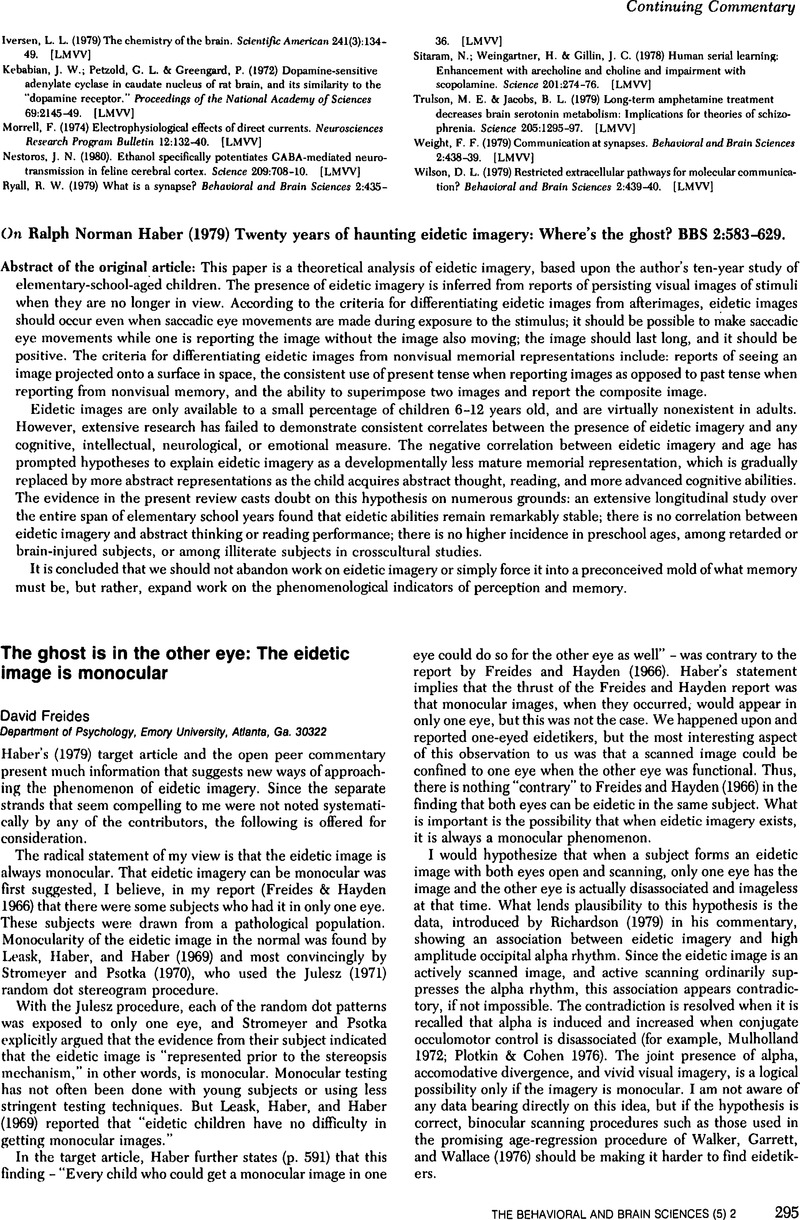No CrossRef data available.
Article contents
What do eidetic images tell us about vision?
Review products
OnHaberRalph Norman (1979) Twenty years of haunting eidetic imagery: Where's the ghost?. BBS 2:583–629.
Published online by Cambridge University Press: 04 February 2010
Abstract
An abstract is not available for this content so a preview has been provided. Please use the Get access link above for information on how to access this content.

Information
- Type
- Continuing Commentary
- Information
- Copyright
- Copyright © Cambridge University Press 1982
References
Freides, D. & Hayden, S. P. (1966) Monocular testing: A methodological note on eidetic imagery. Perceptual and Motor Skills 23:88. [DF]CrossRefGoogle ScholarPubMed
Haber, R. N. (1979) Twenty years of haunting eidetic imagery: Where's the ghost? Behavioral and Brain Sciences 2:583–629. [DF, BK]CrossRefGoogle Scholar
Haber, R. N. (1980) Eidetic images are not just imaginary. Psychology Today 14 (11): 72–82. [RNH]Google Scholar
Julesz, B. (1971) Foundations of Cyclopean perception. Chicago: University of Chicago Press. [DF]Google Scholar
Leask, J.; Haber, R. N. & Haber, R. B. (1969) Eidetic imagery in children: II. Longitudinal and experimental results. Psychonomic Monograph Supplements 3:25–48. [DF, RNH]Google Scholar
Marr, D. & Nishihara, H. K. (1978) Visual information processing: Artificial intelligence and the sensorium of sight. Technology Review 81:28–49. [RNH, BK]Google Scholar
Mulholland, T. B. (1972) Occipital alpha revisited. Psychological Bulletin 78:176–82. [DF]CrossRefGoogle ScholarPubMed
Plotkin, W. B. & Cohen, R. (1976) Occipital alpha and the attributes of the “alpha experience.” Psychophysiology 13:16–21. [DF]CrossRefGoogle ScholarPubMed
Pylyshyn, Z. W. (1980) Computation and cognition: Issues in the foundation of cognitive science. Behavioral and Brain Sciences 3:111–69. [RNH]CrossRefGoogle Scholar
Richardson, A.Eidetic imagery, occipital EEC activity, and palinopsia. Behavioral and Brain Sciences 2:613. [DF]CrossRefGoogle Scholar
Stromeyer, C. F. III & Psotka, J. (1970) The detailed texture of eidetic images. Nature 225:347–49. [DF, BK]CrossRefGoogle ScholarPubMed
Walker, N. S.; Garrett, J. B. & Wallace, B. (1976) Restoration of eidetic imagery via hypnotic age regression: A preliminary report. Journal of Abnormal Psychology 85:335–37. [DF]CrossRefGoogle ScholarPubMed
Zaidel, E. (1975) A technique for presenting lateralized visual input with prolonged exposure. Vision Research 15:283–89. [DF]CrossRefGoogle ScholarPubMed

